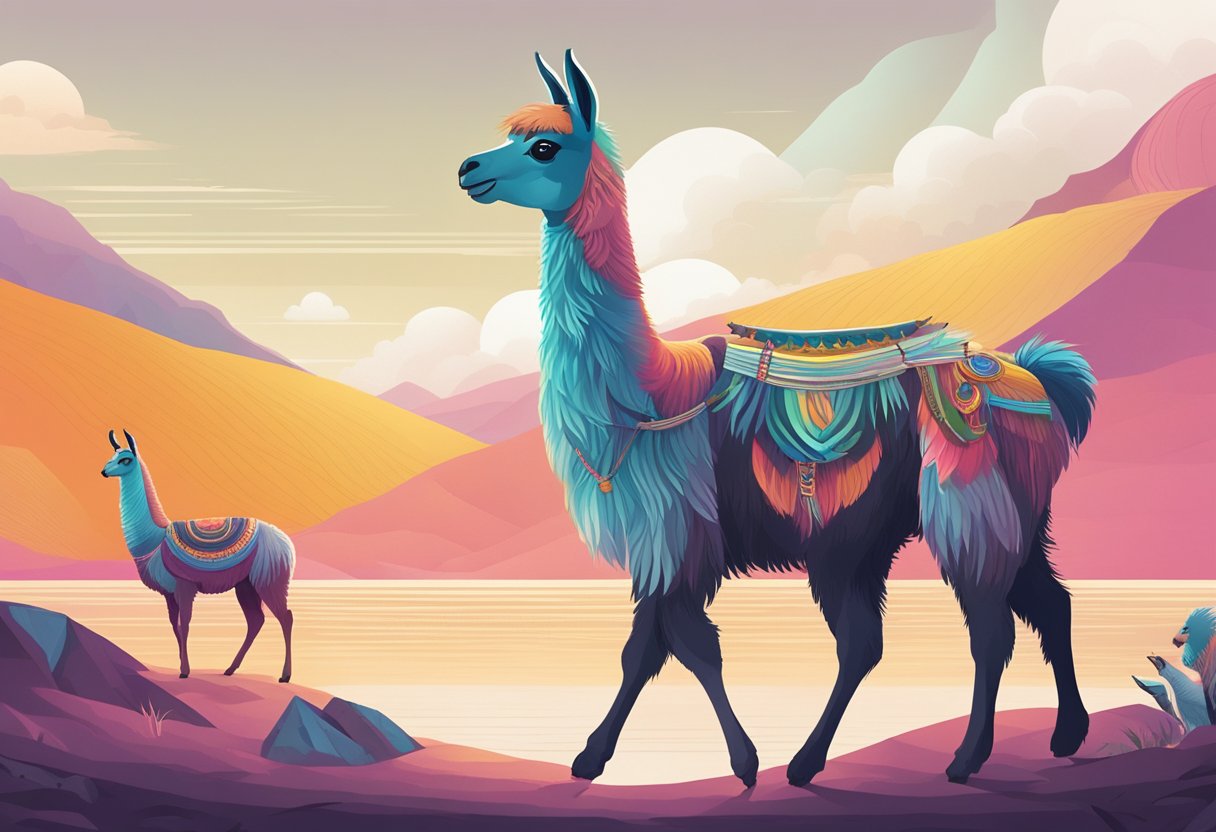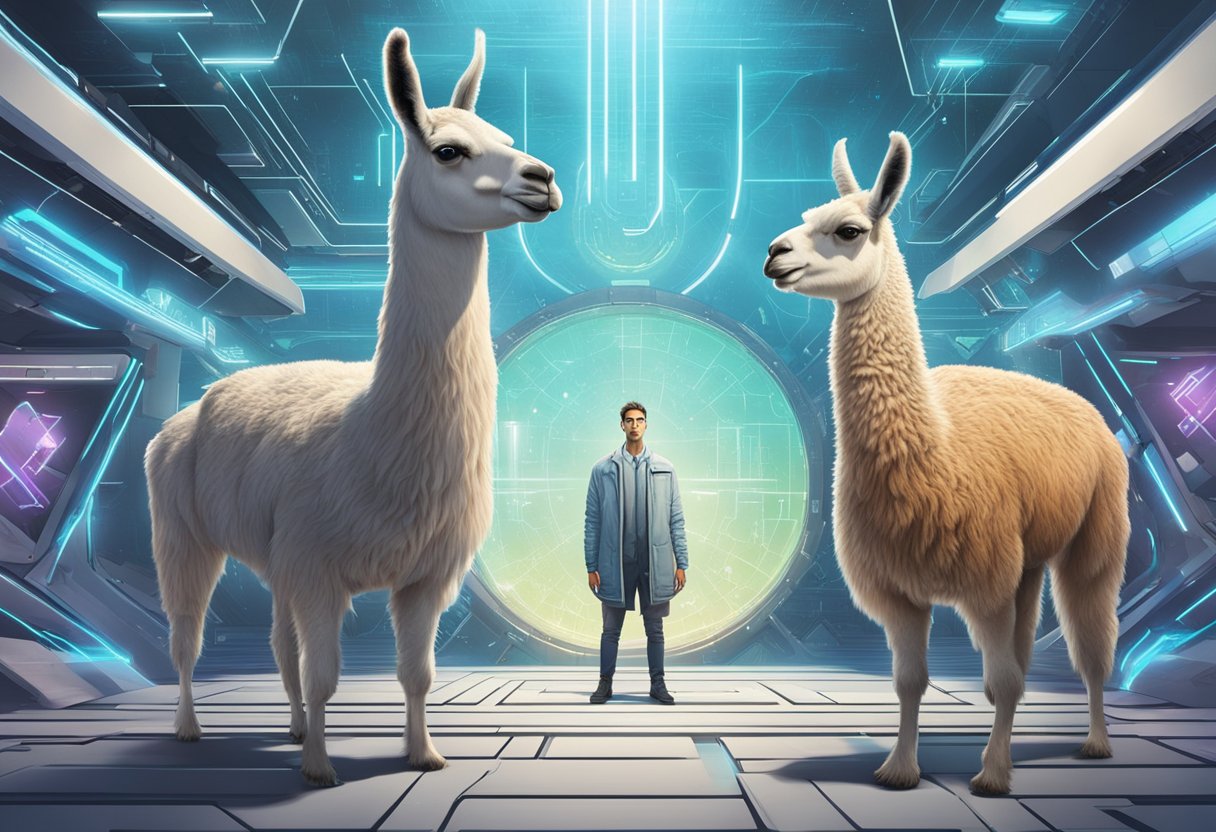While ChatGPT 4 has made waves with its ability to engage in meaningful dialogue, providing responses that seem almost human, Meta’s LLaMA 2 stands out with its ability to be self-hosted, offering a different approach to accessibility and efficiency in AI technology.
Both models have their use cases and advantages, which cater to different needs and preferences. If you’re interested in chatbots or language translation, you might find LLaMA’s efficiency and smaller parameter options as noted by GeeksforGeeks quite appealing. Alternatively, the depth and contextual understanding demonstrated by ChatGPT 4 might be more aligned with your requirements for generating text or engaging in complex conversations.
Understanding these differences is crucial when deciding the right tool for your project or study. Comparing LLaMA’s optimized performance for dialogue use cases against ChatGPT’s conversational expertise—as highlighted by sources like CareerFoundry—can help you make an informed choice about which model aligns best with your goals.
The ongoing development and improvement of such technologies promise even more advanced capabilities in the near future, reinforcing the potential of AI in various sectors.
Understanding AI and Language Models
In the realm of AI, language models like LLaMA and ChatGPT stand as testaments to how machine learning technologies have grown. This section will help you grasp their importance and evolution.
The Evolution of AI
AI development has been a tale of continual advancement, marked by the quest to create machines that replicate human intelligence. You’ve witnessed this progress from rule-based systems to machine learning, where algorithms learn patterns from data. OpenAI and Meta AI are at the forefront, pushing the boundaries of what AI can do with language models that can understand and generate human-like text.
The Role of Large Language Models (LLMs)
Large Language Models (LLMs), like ChatGPT from OpenAI, have revolutionized tasks that require understanding human language. These LLMs are trained on extensive text datasets, allowing them to predict the next word in a sentence or answer complex questions. Meta AI’s LLaMA is another example, highlighting the critical role of LLMs in current AI applications, from automating customer service to aiding with research inquiries. The efficiency of these models lies in their transformer architecture, enabling them to contextualize words in a sentence rather than viewing them in isolation.
What Is LLaMA?
When exploring the world of AI, you’ll find LLaMA intriguing as it showcases a fine balance between power and efficiency in language processing.
Overview of LLaMA
LLaMA, or Language Model for Many Applications, is a neural network-based language model developed by Meta. Unlike some larger models, LLaMA boasts an impressive but manageable 70 billion parameters, making it both robust and relatively resource-efficient. Your understanding of LLaMA begins with recognizing it as a transformative tool in natural language processing, leveraging transformer networks to generate and comprehend text.
Meta’s Vision for LLaMA
Meta’s vision for LLaMA is to democratize access to powerful AI models. By designing it to require less computational power, Meta intends for LLaMA to be more accessible, so you can utilize it even if you don’t have the most cutting-edge hardware. Moreover, Meta’s implementation of LLaMA aims to facilitate diverse applications while maintaining effectiveness and accuracy.
You may also like 📖
ChatGPT: OpenAI’s Conversational Marvel
Introduction to ChatGPT
ChatGPT functions on a transformer architecture, a type of deep learning model that has revolutionized the way machines understand and process human language.
ChatGPT is trained with a massive dataset, boasting 13 billion parameters, which allows it to comprehend and respond to a vast range of topics. Whether you’re looking for a casual chat or needing assistance with complex inquiries, ChatGPT’s versatile capabilities make it an impressive conversationalist.
OpenAI’s Development of ChatGPT
OpenAI’s journey in creating ChatGPT was monumental. Building upon the foundation of the earlier generative pre-trained transformer models, GPT-3 was a leap forward in natural language processing. It was designed to interact in natural, conversational patterns and could perform a variety of tasks without requiring task-specific training.
Their creation, OpenAI’s ChatGPT 4, took the flexibility of GPT-3 and fine-tuned it for the art of conversation. OpenAI’s emphasis on nuanced understanding and context retention enabled ChatGPT to break new ground, offering users an AI that could learn from the conversation and provide coherent and contextually rich dialogue.
Comparing LLaMA 2 and ChatGPT
When exploring LLaMA 2 and ChatGPT 4, you’ll find distinct differences in their architectures and varied performance benchmarks that distinguish their optimal use cases.
Differences in Design
LLaMA 2 and ChatGPT 4 are designed with specific purposes and user experiences in mind. LLaMA is capable of being privately hosted, which can be highly beneficial for startups and smaller companies seeking more control over their AI infrastructure. It also offers models with fewer parameters, which can result in more straightforward accessibility for users with limited computational resources. In contrast, ChatGPT is known for its large-scale model with GPT-3 featuring over 175 billion parameters, requiring considerably more computational horsepower to operate efficiently.
Performance Benchmarks
Performance can vary considerably between LLaMA 2 and ChatGPT 4, with each having its own advantages and disadvantages. Your experience with LLaMA might be more cost-effective, and it’s noted for its factually accurate responses even with a smaller size, which could make it a pragmatic choice for a wide variety of applications. On the other hand, despite its slower pace and higher computational demands, ChatGPT offers an extensive database and performs very well at scale. With regards to web traffic, ChatGPT has been reported to receive more visitation, suggesting its widespread adoption and potential dependability. However, LLaMA has demonstrated a higher growth rate, indicating a rapidly increasing interest and usage.
Features and Capabilities

In exploring the features and capabilities of ChatGPT 2 and LLaMA 4, you’ll uncover distinct characteristics that make each powerful in their own right. We’ll dive into what sets them apart, focusing on their advanced offerings in areas such as language translation, coding capabilities, efficiency, and creative writing.
Understanding ChatGPT’s Advanced Features
With ChatGPT, you’re harnessing a model designed to understand and generate human-like text.
- Creative Writing:
- Flair for Storytelling: ChatGPT stands out with its ability to help you craft compelling narratives and pieces of creative writing.
- Code Comprehension: It can not only understand queries but also assist with generating code snippets in various programming languages.
- Language Translation:
- Although not its primary function, ChatGPT can provide rough translations across multiple languages, demonstrating its versatility in handling diverse linguistic tasks.
Key Features of LLaMA
LLaMA, on the other hand, showcases a range of key features that cater to different necessities.
- Efficiency:
- Lean and Mean: Noteworthy for its efficiency, LLaMA aims to deliver high-level performance, even in environments with limited computational resources.
- Parameter Choices: It provides various parameter options, streamlining its access and implementation for startups and smaller organizations (GeeksforGeeks).
- Use Cases:
- Tailored for Dialogue: Optimized for dialogue, LLaMA excels as a training tool for customer service chatbots and similar applications (CareerFoundry).
- Language Translation Tools: Its efficiency paves the way for its use in quick-processing applications like chatbots and language translation tools.
Applications in Different Industries
AI technologies like ChatGPT 4 and LLaMA are revolutionizing the way various industries operate. You’ll find these tools enhancing efficiency, providing insightful analytics, and simplifying complex tasks.
How ChatGPT Serves Various Sectors
In healthcare, ChatGPT can be a game changer by assisting in patient care and administrative tasks. You can see it being used to provide symptom analysis, support healthcare providers with information retrieval, and even help in mental health counseling.
When it comes to education, this AI provides personalized learning experiences. It enables interactive tutoring for students and serves as a resourceful assistant for educators to prepare teaching materials and quizzes.
For businesses, ChatGPT is a powerful ally in customer service. It’s capable of handling inquiries through chatbots and language translation tools, helping to scale operations without compromising the quality of customer interactions.
You may also like 📖
- 7 Time-Saving Tricks with ChatGPT
- World’s Largest Supercomputer for AI training is out – and available for you to use
- How ChatGPT Will Destabilize White-Collar Work
- ChatGPT’s Code Interpreter – Top 6 uses
- 7 Genius Hacks that every ChatGPT user should know
- 7 incredible ways that ChatGPT can help Python programmers
- 7 Key Traits of an Exceptional ChatGPT Prompt Engineer
- 35 ways to use the Code Interpreter of ChatGPT to make money
- 7 insanely complex Excel formulas that ChatGPT can help you with
- ChatGPT can See Images: 10 Best Ways to use the Multimodal Feature
- ChatGPT vs Bard: Example outputs compared, prompts, and our thoughts
- 6 super ways to use ChatGPT’s custom instructions feature
- Are ChatGPT’s Answers Unique?
- Study This: If You Want to Win ChatGPT Prompt Engineering Competitions
- How to Make ChatGPT Write Longer – 10 Ways (with prompts)
- How to Think Like an Expert ChatGPT Prompt Engineer: 7 Proven Strategies
- Generative AI versus Predictive AI
LLaMA’s Potential Impact
LLaMA potentially brings a shift in applications with its capacity for being privately hosted, which is particularly beneficial for startups and smaller organizations looking to employ AI without significant investments in computational infrastructure. As per GeeksforGeeks, its more compact parameter options facilitate easier accessibility, attracting diverse industries looking for cost-effective AI solutions.
In healthcare, LLaMA’s accuracy, despite its smaller size, can streamline diagnostics and research. This efficiency can be crucial in processing medical data swiftly.
In education, tools like LLaMA can update teaching materials with the most current information, given its training with up-to-date data. It may enhance student engagement with contemporary issues, as noted by CareerFoundry.
Businesses can leverage LLaMA’s efficiency for a wide scope of applications, from developing customer service chatbots to implementing digital marketing techniques, focusing on dialogue-driven tasks.
Both tools have a lot to offer across sectors, and your understanding of their applications can help you choose which AI is right for your industry’s needs.
Developer Experience and Support
When you choose between ChatGPT and LLaMA for development, consider the community support, tools, and resources available to streamline your workflow.
Support for ChatGPT Developers
For those of you developing with ChatGPT 4, you’ll find robust community support primarily due to its widespread adoption, and its affiliation with OpenAI provides a solid backstop for developers. The Hugging Face platform, a hub for machine learning models, includes ChatGPT and offers tools and open-source libraries such as transformers that can help you effortlessly integrate language models into your applications.
Tools and Resources for LLaMA 2 Developers
As a LLaMA 2 developer, you benefit from its ability to be privately hosted, which suits startups and smaller companies. You have access to more compact parameter models, easing deployment on diverse systems. For open-source support, LLaMA is backed by Meta AI and is gaining a growing repository of tools and documentation aimed at boosting developer efficiency.
Accessibility and Licensing

When you’re considering using AI models like LLaMA 2 or ChatGPT 4, understanding how you can access them and what the licensing entails is crucial for your projects. These factors determine how you can implement and scale AI solutions within your organization.
OpenAI’s Approach to Access
ChatGPT: OpenAI offers ChatGPT, and while it’s not open source, you have the option to access the API under certain terms. The API is available for both commercial and non-commercial use, although your access and usage might be restricted based on the subscription plan you choose. OpenAI’s offerings may require substantial computational resources, especially for the larger, more sophisticated models.
Meta’s Licensing for LLaMA 2
LLaMA: Meta has taken a different route with its AI offering. LLaMA is distributed under a non-commercial license, which typically means you are free to use the model for research and development purposes, but not for commercial projects. LLaMA’s variations in model sizes also cater to differing accessibility needs, allowing the use of the technology even if you’re limited by computational resources.
Note that the accessibility of these AI models can significantly impact your decision-making. It’s important to review their licensing agreements to ensure compliance and align with your intended use cases.
Advantages and Disadvantages
In comparing ChatGPT and LLaMA, you’ll notice that each has its own set of benefits and limitations. These insights into their performance and practicality will help you determine which model aligns with your needs and constraints.
Evaluating ChatGPT 4’s Strengths and Weaknesses
Advantages:
- Versatility: ChatGPT, known for its wide-ranging applicability, can be an asset in various tasks from conversational agents to content creation.
- Robustness: With extensive training on diverse datasets, it demonstrates an ability to handle complex contexts and generate coherent responses.
Disadvantages:
- Resource-Intensive: To operate effectively, ChatGPT often requires substantial computational power, which may pose challenges for lower-budget projects.
- Speed: Given its complexity, it may not be as swift as some of its counterparts, potentially leading to longer response times.
For a deeper dive into how ChatGPT functions, check out this detailed comparison on GeeksforGeeks.
Assessing LLaMA 2’s Pros and Cons
Advantages:
- Efficiency: LLaMA stands out for its efficiency, potentially requiring fewer resources and enabling more flexible deployment scenarios.
- Tailored Models: Smaller, more compact parameter options facilitate easier access, especially for startups and small organizations.
Disadvantages:
- Scope: While optimized for dialogue use cases, LLaMA may not have the breadth of ChatGPT in other applications.
- Data Sensitivity: Since LLaMA is capable of being fine-tuned with newer data, it provides updated information, which implies that it might need regular data refreshes to maintain accuracy.
Learn about the cost-effectiveness and factual accuracy of LLaMA at Software Mind.
Future Potential and Ethical Considerations

When exploring the future of language models like LLaMA and ChatGPT, it’s crucial for you to consider not just how they can innovate and evolve, but also the importance of ensuring their deployment is both safe and ethically sound.
Innovation and Future Applications
LLaMA 2 and ChatGPT 4 are opening new doors in creative writing and other potential applications across various industries. With advanced capabilities, these models could assist in drafting novels, scripting for films, and even generating articles. In the domain of customer service, they could provide more nuanced and human-like interactions. The future may also see them aiding in educational tools, offering personalized learning experiences.
Safe and Ethical Deployment
The safety and ethics surrounding these AI tools carry immense weight. You should consider how models like ChatGPT 4 and LLaMA 2 handle personal data, their susceptibility to manipulation, and their potential impacts on employment in the fields they touch upon. Developers and users alike must strive to ensure that these models are used responsibly, with ethics at the forefront of their deployment. This includes safeguarding against biases within the models and misuse that could be harmful or invasive to user privacy. Your engagement with these technologies should always involve an awareness of both their beneficial potential and the precautions necessary to mitigate risks.



